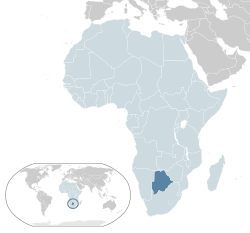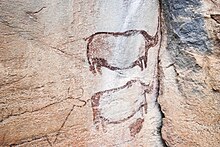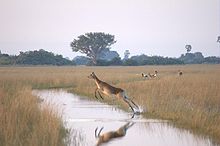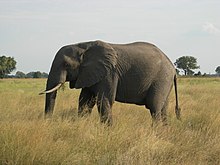Botswana
Republic of Botswana Lefatshe la Botswana (Tswana) | |
|---|---|
 Flag  Coat of arms | |
Motto: "Pula!" (Tswana) "Rain" | |
Anthem: Fatshe leno la rona (Tswana) Blessed Be Our Noble Land | |
 Location of Botswana (dark blue) in the African Union (light blue) | |
| Capital and largest city | Gaborone 24°39.5′S 25°54.5′E / 24.6583°S 25.9083°E / -24.6583; 25.9083 |
| Official languages | English, Setswana |
Ethnic groups |
|
| Religion |
|
| Demonym |
|
| Government | Unitary parliamentary republic |
• President | Mokgweetsi Masisi[1] |
• Vice-President | Slumber Tsogwane |
| Legislature | National Assembly |
Independence from the United Kingdom | |
• Established (Constitution) | 30 September 1966 |
| Area | |
• Total | 581,730 km2 (224,610 sq mi) (47th) |
• Water (%) | 2.6 |
| Population | |
• 2016 estimate | 2,250,260[2] (145th) |
• 2011 census | 1,914,228[3] |
• Density | 3.7/km2 (9.6/sq mi) (231st) |
GDP (PPP) | 2018 estimate |
• Total | $41.6 billion[4] |
• Per capita | $18,843[4] |
GDP (nominal) | 2018 estimate |
• Total | $18.620 billion[4] |
• Per capita | $8,443[4] |
Gini (2009) | very high |
HDI (2017) | high · 101st |
| Currency | Botswana pula (BWP) |
| Time zone | UTC+2 (Central Africa Time) |
| Date format | DD/MM/YYYY |
| Driving side | left |
| Calling code | +267 |
| ISO 3166 code | BW |
| Internet TLD | .bw |
Website www.gov.bw | |
Botswana (/bɒtˈswɑːnə/ (![]() listen)), officially the Republic of Botswana (Tswana: Lefatshe la Botswana), is a landlocked country located in Southern Africa. Formerly the British protectorate of Bechuanaland, Botswana adopted its new name after becoming independent within the Commonwealth on 30 September 1966.[7] Since then, it has maintained a strong tradition of stable representative democracy, with a consistent record of uninterrupted democratic elections and the best perceived corruption ranking in Africa since at least 1998.[8]
listen)), officially the Republic of Botswana (Tswana: Lefatshe la Botswana), is a landlocked country located in Southern Africa. Formerly the British protectorate of Bechuanaland, Botswana adopted its new name after becoming independent within the Commonwealth on 30 September 1966.[7] Since then, it has maintained a strong tradition of stable representative democracy, with a consistent record of uninterrupted democratic elections and the best perceived corruption ranking in Africa since at least 1998.[8]
Botswana is topographically flat, with up to 70 percent of its territory being the Kalahari Desert. It is bordered by South Africa to the south and southeast, Namibia to the west and north, and Zimbabwe to the northeast. Its border with Zambia to the north near Kazungula is poorly defined but is, at most, a few hundred metres long.[9]
A mid-sized country of just over 2 million people, Botswana is one of the most sparsely populated countries in the world. Around 10 percent of the population lives in the capital and largest city, Gaborone. Formerly one of the poorest countries in the world—with a GDP per capita of about US$70 per year in the late 1960s—Botswana has since transformed itself into one of the world's fastest-growing economies. The economy is dominated by mining, cattle, and tourism. Botswana boasts a GDP (purchasing power parity) per capita of about $18,825 per year as of 2015[update], which is one of the highest in Africa.[10] Its high gross national income (by some estimates the fourth-largest in Africa) gives the country a relatively high standard of living and the highest Human Development Index of continental Sub-Saharan Africa.[11]
Botswana is a member of the African Union, the Southern African Development Community, the Commonwealth of Nations, and the United Nations. The country has been among the hardest hit by the HIV/AIDS epidemic. Despite the success in programmes to make treatments available to those infected, and to educate the populace in general about how to stop the spread of HIV/AIDS, the number of people with AIDS rose from 290,000 in 2005 to 320,000 in 2013.[12]:A20 As of 2014[update], Botswana has the third-highest prevalence rate for HIV/AIDS, with roughly 20% of the adult population being infected.[13]
Contents
1 Etymology
2 History
2.1 Early history
2.2 Effects of the Mfecane
2.3 Colonialism and the Bechuanaland Protectorate
2.4 Independence
3 Geography
3.1 Ecology
3.2 Environmental problems
4 Politics and government
4.1 Judiciary
4.2 Foreign relations and military
4.3 Human rights
5 Administrative divisions
6 Economy
6.1 Gemstones and precious metals
7 Demographics
7.1 Languages
7.2 Religions
8 Culture
8.1 Media
8.2 Music
8.3 Visual arts
8.4 Food
8.5 Sports
9 Education
10 Science and technology
11 Health
11.1 General
11.2 HIV/AIDS epidemic
12 Tourism
13 See also
14 Sources
15 References
16 Further reading
17 External links
Etymology
The country's name means "land of the Tswana", referring to the dominant ethnic group in Botswana.[14] The term Batswana was originally applied to the Tswana, which is still the case.[15] However, it has also come to be used generally as a demonym for all citizens of Botswana.[16] Many English dictionaries also recommend the term Botswanan to refer to people of Botswana.[17]
History
Early history

The 'Two Rhino' painting at Tsodilo. Botswana Rock Art.
Archaeological digs have shown that hominids have lived in Botswana for around two million years. Stone tools and fauna remains have shown that all areas of the country were inhabited at least 400,000 years ago.[18] Evidence left by modern humans such as cave paintings are about 73,000 years old.[19] The original inhabitants of southern Africa were the Bushmen (San) and Khoi peoples. Both speak Khoisan languages and hunted, gathered, and traded over long distances. When cattle were first introduced about 2000 years ago into southern Africa, pastoralism became a major feature of the economy, since the region had large grasslands free of tsetse fly.[20]
It is unclear when Bantu-speaking peoples first moved into the country from the north, although AD 600 seems to be a consensus estimate. In that era, the ancestors of the modern-day Kalanga moved into what is now the north-eastern areas of the country. These proto-Kalanga were closely connected to states in Zimbabwe as well as to the Mapungubwe state. These states, located outside of current Botswana's borders, appear to have kept massive cattle herds in what is now the Central District—apparently at numbers approaching modern cattle density.[21] This massive cattle-raising complex prospered until 1300 AD or so, and seems to have regressed following the collapse of Mapungubwe. During this era, the first Tswana-speaking groups, the Bakgalagadi, moved into the southern areas of the Kalahari. All these various peoples were connected to trade routes that ran via the Limpopo River to the Indian Ocean, and trade goods from Asia such as beads made their way to Botswana most likely in exchange for ivory, gold, and rhinoceros horn.[citation needed]
The arrival of the ancestors of the Tswana-speakers who came to control the region has yet to be dated precisely. Members of the Bakwena, a chieftaincy under a legendary leader named Kgabo II, made their way into the southern Kalahari by AD 1500, at the latest, and his people drove the Bakgalagadi inhabitants west into the desert. Over the years, several offshoots of the Bakwena moved into adjoining territories. The Bangwaketse occupied areas to the west, while the Bangwato moved northeast into formerly Kalanga areas.[22] Not long afterwards, a Bangwato offshoot known as the Batawana migrated into the Okavango Delta, probably in the 1790s.[citation needed]
Effects of the Mfecane

British colonial drawing of a "Booshuana village", 1806.
The first written records relating to modern-day Botswana appear in 1824. What these records show is that the Bangwaketse had become the predominant power in the region. Under the rule of Makaba II, the Bangwaketse kept vast herds of cattle in well-protected desert areas, and used their military prowess to raid their neighbors.[23] Other chiefdoms in the area, by this time, had capitals of 10,000 or so and were fairly prosperous.[24] This equilibrium came to end during the Mfecane period, 1823–1843, when a succession of invading peoples from South Africa entered the country. Although the Bangwaketse were able to defeat the invading Bakololo in 1826, over time all the major chiefdoms in Botswana were attacked, weakened, and impoverished. The Bakololo and Amandebele raided repeatedly, and took large numbers of cattle, women, and children from the Batswana—most of whom were driven into the desert or sanctuary areas such as hilltops and caves. Only after 1843, when the Amandebele moved into western Zimbabwe, did this threat subside.[citation needed]
During the 1840s and 1850s trade with Cape Colony-based merchants opened up and enabled the Batswana chiefdoms to rebuild. The Bakwena, Bangwaketse, Bangwato and Batawana cooperated to control the lucrative ivory trade, and then used the proceeds to import horses and guns, which in turn enabled them to establish control over what is now Botswana. This process was largely complete by 1880, and thus the Bushmen, the Kalanga, the Bakgalagadi, and other current minorities were subjugated by the Batswana.[25]
Following the Great Trek, Afrikaners from the Cape Colony established themselves on the borders of Botswana in the Transvaal. In 1852 a coalition of Tswana chiefdoms led by Sechele I resisted Afrikaner incursions, and after about eight years of intermittent tensions and hostilities, eventually came to a peace agreement in Potchefstroom in 1860. From that point on, the modern-day border between South Africa and Botswana was agreed on, and the Afrikaners and Batswana traded and worked together peacefully.[26][27]
Due to newly peaceful conditions, trade thrived between 1860 and 1880. Taking advantage of this were Christian missionaries. The Lutherans and the London Missionary Society both became established in the country by 1856. By 1880 every major village had a resident missionary, and their influence slowly became felt. Khama III (reigned 1875–1923) was the first of the Tswana chiefs to make Christianity a state religion, and changed a great deal of Tswana customary law as a result. Christianity became the de facto official religion in all the chiefdoms by World War I.[28]
Colonialism and the Bechuanaland Protectorate
During the Scramble for Africa the territory of Botswana was coveted by both Germany and Great Britain. During the Berlin Conference, Britain decided to annex Botswana in order to safeguard the Road to the North and thus connect the Cape Colony to its territories further north. It unilaterally annexed Tswana territories in January 1885 and then sent the Warren Expedition north to consolidate control over the area and convince the chiefs to accept British overrule. Despite their misgivings, they eventually acquiesced to this fait accompli.[29]
In 1890 areas north of 22 degrees were added to the new Bechuanaland Protectorate. During the 1890s the new territory was divided into eight different reserves, with fairly small amounts of land being left as freehold for white settlers. During the early 1890s the British government decided to hand over the Bechuanaland Protectorate to the British South Africa Company. This plan, which was well on its way to fruition despite the entreaties of Tswana leaders who toured England in protest, was eventually foiled by the failure of the Jameson Raid in January 1896.[30][31]

Stamp of British Bechuanaland from 1960
When the Union of South Africa was formed in 1910 from the main British colonies in the region, the High Commission Territories — the Bechuanaland Protectorate, Basutoland (now Lesotho), and Swaziland (now Eswatini) — were not included, but provision was made for their later incorporation. However, the UK began to consult with their inhabitants as to their wishes. Although successive South African governments sought to have the territories transferred to their jurisdiction, the UK kept delaying; consequently, it never occurred. The election of the Nationalist government in 1948, which instituted apartheid, and South Africa's withdrawal from the Commonwealth in 1961, ended any prospect of the UK or these territories agreeing to incorporation into South Africa.[citation needed]
An expansion of British central authority and the evolution of tribal government resulted in the 1920 establishment of two advisory councils to represent both Africans and Europeans.[32] The African Council consisted of the eight heads of the Tswana tribes and some elected members.[32] Proclamations in 1934 regulated tribal rule and powers. A European-African advisory council was formed in 1951, and the 1961 constitution established a consultative legislative council.
Independence
In June 1964, the United Kingdom accepted proposals for a democratic self-government in Botswana. The seat of government was moved in 1965 from Mafikeng in South Africa, to the newly established Gaborone, which is located near Botswana's border with South Africa. Based on the 1965 constitution, the country held its first general elections under universal suffrage and gained independence on 30 September 1966.[33]Seretse Khama, a leader in the independence movement and the legitimate claimant to the Ngwato chiefship, was elected as the first President, and subsequently re-elected twice.
The presidency passed to the sitting Vice-President, Quett Masire, who was elected in his own right in 1984 and re-elected in 1989 and 1994. Masire retired from office in 1998. He was succeeded by Festus Mogae, who was elected in his own right in 1999 and re-elected in 2004. The presidency passed in 2008 to Ian Khama (son of the first President), who had been serving as Mogae's Vice-President since resigning his position in 1998 as Commander of the Botswana Defence Force to take up this civilian role.
A long-running dispute over the northern border with Namibia's Caprivi Strip was the subject of a ruling by the International Court of Justice in December 1999. It ruled that Kasikili Island belongs to Botswana.[34]
Geography

Botswana map of Köppen climate classification.

A lechwe in the Okavango Delta
At 581,730 km2 (224,607 sq mi) Botswana is the world's 48th-largest country. It is similar in size to Madagascar or France. It lies between latitudes 17° and 27°S, and longitudes 20° and 30°E.
The country is predominantly flat, tending toward gently rolling tableland. Botswana is dominated by the Kalahari Desert, which covers up to 70% of its land surface. The Okavango Delta, one of the world's largest inland deltas, is in the northwest. The Makgadikgadi Pan, a large salt pan, lies in the north.
The Limpopo River Basin, the major landform of all of southern Africa, lies partly in Botswana, with the basins of its tributaries, the Notwane, Bonwapitse, Mahalapye, Lotsane, Motloutse and the Shashe, located in the eastern part of the country. The Notwane provides water to the capital through the Gaborone Dam. The Chobe River lies to the north, providing a boundary between Botswana and Namibia's Zambezi Region. The Chobe River meets with the Zambezi River at a place called Kazungula (meaning a small sausage tree, a point where Sebitwane and his Makololo tribe crossed the Zambezi into Zambia).
Ecology

Botswana has the largest elephant population in the world

Plains zebra (Equus quagga) in Okavango
Botswana has diverse areas of wildlife habitat. In addition to the delta and desert areas, there are grasslands and savannas, where blue wildebeest, antelopes, and other mammals and birds are found. Northern Botswana has one of the few remaining large populations of the endangered African wild dog. Chobe National Park, found in the Chobe District, has the world's largest concentration of African elephants. The park covers about 11,000 km2 (4,247 sq mi) and supports about 350 species of birds.
The Chobe National Park and Moremi Game Reserve (in the Okavango Delta) are major tourist destinations. Other reserves include the Central Kalahari Game Reserve located in the Kalahari desert in Ghanzi District; Makgadikgadi Pans National Park and Nxai Pan National Park are in Central District in the Makgadikgadi Pan. Mashatu Game Reserve is privately owned: located where the Shashe River and Limpopo River meet in eastern Botswana. The other privately owned reserve is Mokolodi Nature Reserve near Gaborone. There are also specialised sanctuaries like Khama Rhino Sanctuary (for rhinoceros) and Makgadikgadi Sanctuary (for flamingos). They are both located in Central District.
Environmental problems

A baobab tree (Adansonia digitata)
Botswana faces two major environmental problems: drought and desertification. The desertification problems predominantly stem from the severe times of drought in the country. Three quarters of the country's human and animal populations depend on groundwater due to drought. Groundwater use through deep borehole drilling has somewhat eased the effects of drought. Surface water is scarce in Botswana and less than 5% of the agriculture in the country is sustainable by rainfall. In the remaining 95% of the country, raising livestock is the primary source of rural income. Approximately 71% of the country's land is used for communal grazing, which has been a major cause of the desertification and the accelerating soil erosion of the country.[35]
Since raising livestock has proven to be profitable for the people of Botswana, they continue to exploit the land. The animal populations have continued to dramatically increase. From 1966 to 1991, the livestock population has increased from 1.7 million to 5.5 million.[35]:64 Similarly, the human population has increased from 574,000 in 1971 to 1.5 million in 1995, a 161% increase in 24 years. "Over 50% of all households in Botswana own cattle, which is currently the largest single source of rural income." "Rangeland degradation or desertification is regarded as the reduction in land productivity as a result of overstocking and overgrazing, or as a result of veld product gathering for commercial use. Degradation is exacerbated by the effects of drought and climate change."[35]
Environmentalists report that the Okavango Delta is drying up due to the increased grazing of livestock.[36] The Okavango Delta is one of the major semi-forested wetlands in Botswana and one of the largest inland deltas in the world; it is a crucial ecosystem to the survival of many animals.[36]
The Department of Forestry and Range Resources has already begun to implement a project to reintroduce indigenous vegetation into communities in Kgalagadi South, Kweneng North and Boteti.[37] Reintroduction of indigenous vegetation will help with the degradation of the land. The United States Government has also entered into an agreement with Botswana, giving them $7 million US dollars to reduce Botswana's debt by $8.3 million US dollars. The stipulation of the US reducing Botswana's debt is that Botswana will focus on more extensive conservation of the land.[36]
The United Nations Development Programme claims that poverty is a major problem behind the overexploitation of resources, including land, in Botswana. To help change this the UNDP joined in with a project started in the southern community of Struizendam in Botswana. The purpose of the project is to draw from "indigenous knowledge and traditional land management systems". The leaders of this movement are supposed to be the people in the community, to draw them in, in turn increasing their possibilities to earn an income and thus decreasing poverty. The UNDP also stated that the government has to effectively implement policies to allow people to manage their own local resources and are giving the government information to help with policy development.[38]
Politics and government

House of the Parliament of Botswana in Gaborone
The constitution of Botswana is the rule of law, which protects the citizens of Botswana and represents their rights. The politics of Botswana take place in a framework of a representative democratic republic, whereby the President of Botswana is both head of state and head of government, and of a multi-party system. Executive power is exercised by the government. Legislative power is vested in both the government and the Parliament of Botswana. The most recent election, its eleventh, was held on 24 October 2014. Since independence was declared, the party system has been dominated by the Botswana Democratic Party.
Judiciary
The judiciary is independent of the executive and the legislature.[39] Botswana ranks 30th out of 167 states in the 2012 Democracy Index.[40] According to Transparency International, Botswana is the least corrupt country in Africa and ranks close to Portugal and South Korea.[41]
It consists of a typical court system of local Magistrates Courts, a High Court and a Court of Appeal. The High Court is a superior court of record with unlimited original jurisdiction to hear and determine any criminal, civil or constitutional cases under any law. Appeals can be heard by the Court of Appeal. The Head of the High Court is the Chief Justice.[42]
The Court of Appeal is the highest and final court in the country and deals with appeals from the High Court and the Industrial Court. The Head of the Court of Appeal is the Judge President.
Judges are appointed by the President of Botswana on the recommendation of the Judicial Services Commission.
Chief Justices:[43]
- 1968–1971 John Richard Dendy-Young
- 1972–1975 Akinola Aguda
- 1975–1977 George O.L. Dyke
- 1977–1981 Hayfron Benjamin
- 1981–1987 O'Brien Quinn
- 1987–1992 Livesey Luke
- 1992–1997 Moleleki Didwell Mokama
- 1997–2010 Julian Mukwesu Nganunu
- 2010–2018 Maruping Dibotelo
- Incumbent Terence Rannowane
With regard to the legal profession, although the Law Society of Botswana has been in existence since 1997,[44] there is still no clear indication in their registry of attorneys as to how certain demographics, such as women, have fared in the legal field.
Foreign relations and military

Signs at the Botswana–South Africa border, 2010
At the time of independence, Botswana had no armed forces. It was only after the Rhodesian and South African militaries struck respectively against the Zimbabwe People's Revolutionary Army and Umkhonto we Sizwe[45] bases that the Botswana Defence Force (BDF) was formed in 1977.[46] The President is commander-in-chief of the armed forces and appoints a defence council and the BDF currently consists of roughly 60,000 servicemen.
Following political changes in South Africa and the region, the BDF's missions have increasingly focused on prevention of poaching, preparing for disasters, and foreign peacekeeping. The United States has been the largest single foreign contributor to the development of the BDF, and a large segment of its officer corps have received U.S. training. The Botswana government gave the United States permission to explore the possibility of establishing an Africa Command (AFRICOM) base in the country.[47]
Human rights
Many of the indigenous San people have been forcibly relocated from their land onto reservations. To make them relocate, they were denied from accessing water from their land and faced arrest if they hunted, which was their primary source of food.[48] Their lands lie in the middle of the world's richest diamond field. Officially, the government denies that there is any link to mining and claims the relocation is to preserve the wildlife and ecosystem, even though the San people have lived sustainably on the land for millennia.[48] On the reservations, they struggle to find employment and alcoholism is rampant.[48]
On 24 August 2018 the UN Special Rapporteur on Minorities, Fernand de Varennes issued a statement calling on Botswana, “to step up efforts to recognize and protect the rights of minorities in relation to public services, land and resource use and the use of minority languages in education and other critical areas.”
Homosexual acts are illegal in Botswana, as in many African countries.[49]
Capital punishment in Botswana includes the death penalty by hanging.
The Botswana Centre for Human Rights, Ditshwanelo, was established in 1993.[50]